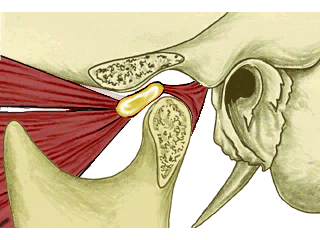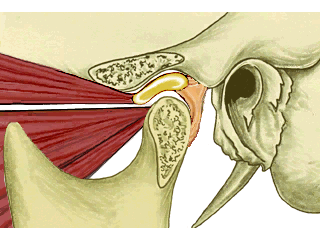Normal TMJ Function
Closed
Posterior band of disc envelops superior part of condyle
Intermediate and anterior band between condyle and posterior slope of articular eminence
Partly Open
Posterior band goes more posterior to condyle as it rotates
Intermediate zone becomes articulating surface between condyle and eminence
Maximum Opening
Condyle rotate under anterior band and generally translates to area below eminence
Partly Closed
Same as partly open
Disc Displacement with Reduction
Closed
Posterior band located infront of condyle
Partly Open
Condyle moves forward and disc obstructs movement
Forces on disc causes tension that overcomes forces of condyle = click
Click occurs because condyle strikes articular eminence
Maximum Opening
Same as Normal
Partly Closed
Disc moves anterior again causing click
Click occurs because condyle strikes articular eminence
Disc Displacement without Reduction with Limited Opening
Closed
Same as with Reduction
Partly Open
Disc obstructs movement but maintains anterior position
Maximum Opening
Limited opening due to limited translation of condyle
No click
Partly Closed
Same as with Reduction
Disc Displacement without Reduction with Unlimited Opening
Closed
Same as with Reduction
Partly Open
Same as with Reduction
Maximum Opening
Disc doesn't impinge on movement but remains anteriorly, medially or laterally
Partly Closed
Same as with Reduction
Subluxation
Closed
Same as Normal
Partly Open
Same as Normal
Maximum Opening
Normal until nearly fully open
Condyle and disc anteriorly displaced past eminence (open-lock)
Click late on opening
Partly Closed
Click early on closing
Otherwise Normal




